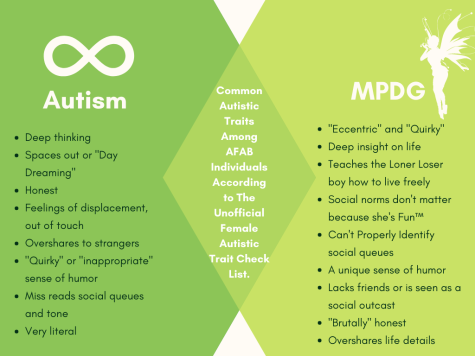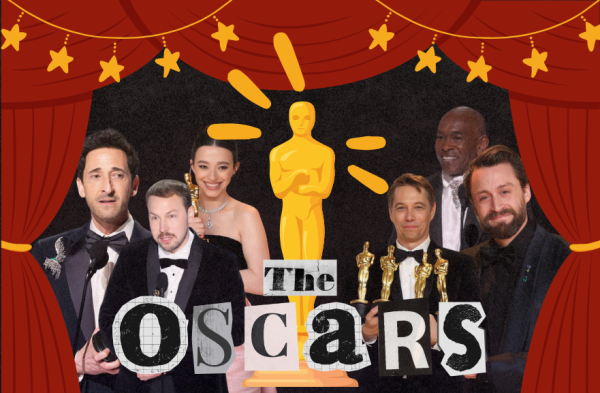Manic Pixie Dream Girl, Disguised Autism
Manic Pixie Dream Girl, an impulsive, quirky, one-dimensional girl created for the sad, soggy boy protagonist. She is this life force that he’s never witnessed. She’s fun, and he’s afraid of change. She can change him, and he can use her friendliness against her. She’s a cardboard cutout of a girl, pretty with no substance but “not like other girls,” so she appears deeper than the writers have made her. This misconception we have, while she may seem perfectly chaotic and beautiful with all these niche traits, creates someone who isn’t a person at all. Not a fully fleshed-out character, just an extension of the white male protagonist. An overused, repetitive trope that we’re sick of.
If you’ve never noticed this manic dream girl trope, or haven’t seen Scott Pilgrim vs. The World, then this is probably all new information. The easiest-to-spot traits of this trope are nonsensical humor, impulse decisions, outlandishly whimsical, brutal honesty, and unique style choice. You might recognize some characters that fall under this trope, arguably one of the most famous characters that fall under this trope is Holly Golightly from Breakfast at Tiffany’s (1961). Other popular characters like Ramona Flowers and Summer; from Scott Pilgrim and 500 Days of Summer (2009) also fall into this trope. Honorable mention, Sam from Garden State (2004) was one of the first to be instated with this “Manic Pixie Girl” name.
Looking at this trope, it’s clearly made for the male gaze and was crafted specifically for males that are similar to the protagonists. It’s clear that there is deep-rooted misogyny in these one-dimensional characters. These characters are shallow, with their only personality trait being quirky. Their only concern is being the romantic interest. Men created this archetype to play out their fantasy of this fun unrealistic girl, so why do we see this character so often?
Sarah Hart, a senior at Huntington Beach High, said, “For impressionable young people, the Manic Pixie Dream Girl does more harm than she might [have] if she actually existed in real life…the Manic Pixie Dream Girl isn’t a fully developed person. She is a half-baked and not fully-formulated character without any discernible character development. People don’t actually exist like that.”
When autistic women spoke up about the odd similarities they found between themselves and the characters that fall within this trope, other neurodivergent and AFAB (assigned female at birth) individuals have noticed this weird resemblance. The Manic Pixie Dream Girl ends up feeling like the infamous romanticization of autism.
We even see this trope in books, one of the most famous writers of this trope being John Green. This trope is heavily featured in his books The Fault in Our Stars, Paper Towns, and Looking for Alaska, which are critically acclaimed and massively popular. This just goes to show how common this character type really is and how it has pervaded all forms of media, from movies to books. Has it not gotten old?
The MPDG is harmful to autistic women as it reduces autistic women to a concept, an ideal that troubled men must find in order to recover from their particular brand of existential nihilism.
Beyond the other problematic aspects of this trope, this trope makes autistic women into something else. Someone overly romanticized and pushed to a standard outside of themselves, how society wants autistic individuals to act. If these girls in the media are made out to have no substance, just glitter, and hair dye, this shoves autistic AFAB individuals back to continually not being seen as people. Not only does this affect the consumers of media that this idea exists in, it also creates a new realm of romanticization and dips into the infantilization of AFAB autistic people. This “broken sad girl” is idealistic in that she can be saved while saving the protagonist from his “brooding outlook on life” or be a classic damsel in distress.
Neurotypical people often have issues with people that are unlike them. Their perception of autistic people is that a person’s autism works against them, making them not a person, but “an autistic.” The shallowness of characters like Ramona Flowers is a setback in how autistic women are perceived, not to mention how these Manic Pixie Dream Girls are demonized as well. The connection to these characters is full of harm, not representation. These women are not seen as their own identity; they have no life outside of the male protagonist they were assigned.
“Too many guys think I’m a concept, or I complete them, or I’m gonna make them alive. But I’m just a … girl who’s lookin’ for my own peace of mind; don’t assign me yours,” as Clementine from Eternal Sunshine of the Spotless Mind (2004) puts it.
It should not be the job of a woman who were put under this trope, autistic women who were placed under the “Manic Pixie Dream Girl.” Society should not emotionally tax autistic individuals by making them think it’s their job to help men or anyone. Statistically, autistic women are more prone to mental and emotional abuse.
Nothing is worse than a girl with a mind of her own that isn’t built for the male gaze (sarcasm).
To get a good idea of the connection between this trope and autism, we look at the character Susan “Stargirl” Caraway from the 2020 movie Stargirl. Many people had a negative reaction to this character because they unrightfully labeled her as a Manic Pixie Dream Girl type. However, others could agree that her character is in likeness to that of someone with autism. Stargirl was deeply hated for being this outlandish girl that is out of touch with people, but I think her character was a fair representation of an autistic character without being explicitly labeled as such, even with her whimsical personality traits.
Seeing that her character was hated and still given this dehumanizing title, it’s clear that people don’t intend for these MPDG to be seen as autistic. The controversy lies with misrepresentation. A good term for this is “Hollywood Autism.” It’s clear the writer’s intention wasn’t to make an autistic character, but these girls’ traits ended up being perceived in that way. Looking at the similarities of these traits, the cross-over points are traits often neurotypical people call “high-functioning.” This term is generally used to describe how much of a nuisance an autistic individual is to neurotypicals and society, or how well they can mask. This idea of “Hollywood Autism” is that it takes the more “tolerable” traits of autism and makes it into this cutesy, fun, girl character that is nothing but mysterious and fun.
While we can look at this trope and recognize the poor writing in these female characters, we can also acknowledge a male counterpart. Equally as shallow, the Manic Pixie Dream Boy is not a trope taken from life but is still controversial. Although misogyny is at the root of the Manic Pixie Dream Girl trope, its male counterpart does not put the characters through the same dehumanization. We can see similar autistic traits in these male characters as well though when the harmfulness of these two characters are compared, autistic men are not the ones to denounce this trope rather than men who feel that it creates an unrealistic man for women to adore. These characters are always more favored by society because they are male; the world was created for him to be loved at the very conception of whatever piece of media he exists in.
One of the first recognized Manic Pixie Dream Boys was Augustus Waters from The Fault in Our Stars. Entertainment Journalist Matt Patches says, “He’s a bad boy, he’s a sweetheart, he’s a dumb jock, he’s a nerd, he’s a philosopher, he’s a poet, he’s a victim, he’s a survivor, he’s everything everyone wants in their lives.”
Overall, not only is this trope harmful to a wide range of individuals, but this trope has also been heavily overdone across multiple forms of media. Seeing the same “unfinished” characters gets old and repetitive fast. With the media speaking out about the harm of this trope, we can hope to see less of it, once more people prove it to be useless as scriptwriting evolves.

Your donation will support the student journalists of Huntington Beach High School. Your contribution will allow us to cover our annual website hosting costs.
Thank you for supporting our program!






